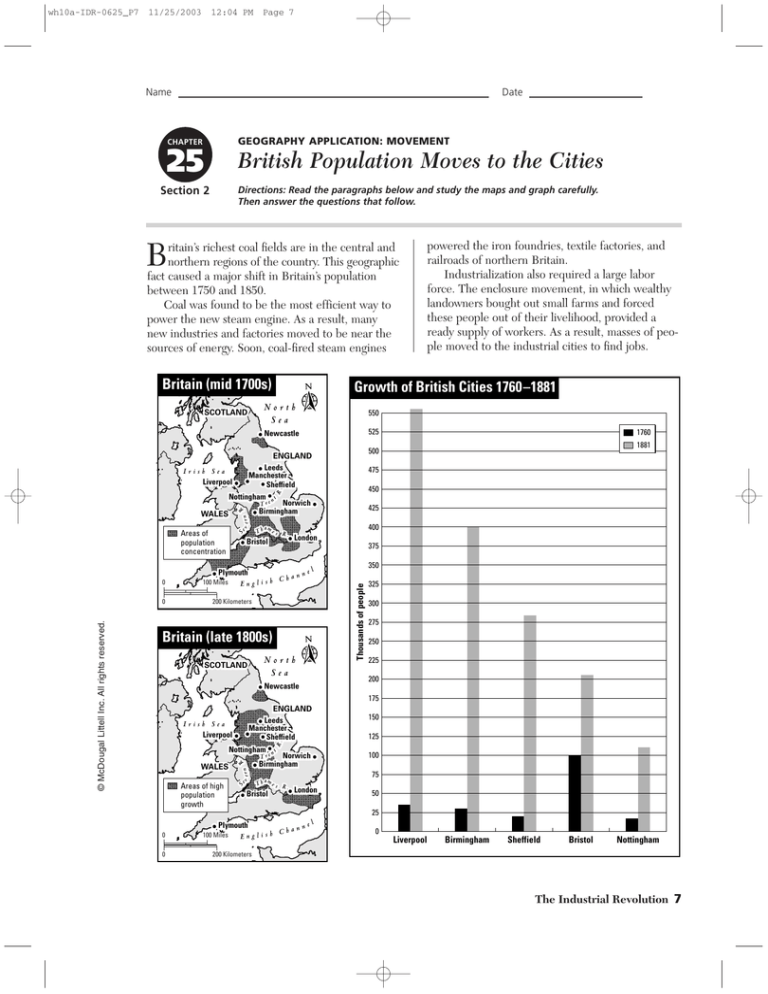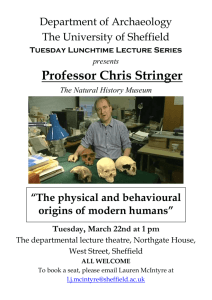
wh10a-IDR-0625_P7
11/25/2003
12:04 PM
Page 7
Name
Date
CHAPTER
GEOGRAPHY APPLICATION: MOVEMENT
25
British Population Moves to the Cities
Section 2
Directions: Read the paragraphs below and study the maps and graph carefully.
Then answer the questions that follow.
B
ritain’s richest coal fields are in the central and
northern regions of the country. This geographic
fact caused a major shift in Britain’s population
between 1750 and 1850.
Coal was found to be the most efficient way to
power the new steam engine. As a result, many
new industries and factories moved to be near the
sources of energy. Soon, coal-fired steam engines
y
yyyy
y
yyy
y
yyy
yyy
y
Britain (mid 1700s)
SCOTLAND
Growth of British Cities 1760–1881
North
Sea
550
Newcastle
525
R.
450
am e
s R.
400
London
375
l
Plymouth
ne
Chan
100 Miles
English
200 Kilometers
Britain (late 1800s)
North
Sea
SCOTLAND
425
Newcastle
350
Thousands of people
Th
Bristol
325
300
275
250
225
200
175
ENGLAND
Leeds
Manchester
Sheffield
Sheffield
150
125
R.
Irish Sea
Liverpool
Nottingham n t
Norwich
Tre
Birmingham
WALES
ALES
Areas of high
population
growth
0
0
S
v ern
R.
© McDougal Littell Inc. All rights reserved.
0
S
v ern
R.
0
e
1881
475
Nottingham n t
Norwich
Tre
Birmingham
WALES
ALES
Areas of
population
concentration
1760
500
ENGLAND
Leeds
Manchester
Sheffield
Sheffield
Irish Sea
Liverpool
powered the iron foundries, textile factories, and
railroads of northern Britain.
Industrialization also required a large labor
force. The enclosure movement, in which wealthy
landowners bought out small farms and forced
these people out of their livelihood, provided a
ready supply of workers. As a result, masses of people moved to the industrial cities to find jobs.
e
Th
am e
Bristol
s R.
London
l
Plymouth
ne
Chan
100 Miles
English
100
75
50
25
0
Liverpool
Birmingham
Sheffield
Bristol
Nottingham
200 Kilometers
The Industrial Revolution 7
wh10a-IDR-0625_P8
11/25/2003
12:04 PM
Page 8
Name
British Population Moves to the Cities continued
Interpreting Text and Visuals
1. Of the cities shown on the bar graph, which one had the largest population increase between
1760 and 1881? the smallest? ____________________________________________________
____________________________________________________________________________
2. What mode of transportation did all English companies have to have in order to transport their
goods to Europe? ______________________________________________________________
____________________________________________________________________________
3. Which two cities appear to have missed out on the Industrial Revolution in England? ______
____________________________________________________________________________
4. Where was most of the English population living in 1750? in 1850? What caused this major
population shift? ______________________________________________________________
____________________________________________________________________________
____________________________________________________________________________
____________________________________________________________________________
____________________________________________________________________________
5. If you are a factory owner in Sheffield and your workers have just completed an order of clothes,
about how many miles would you have to travel to sell them in London? __________________
6. What is the approximate total population of the five cities on the chart in 1760? How much did
that total population increase by 1881? ____________________________________________
____________________________________________________________________________
7. Why do you think it is important for factories and mills to be near their sources of energy?
____________________________________________________________________________
____________________________________________________________________________
8 Unit 6, Chapter 25
© McDougal Littell Inc. All rights reserved.
____________________________________________________________________________








